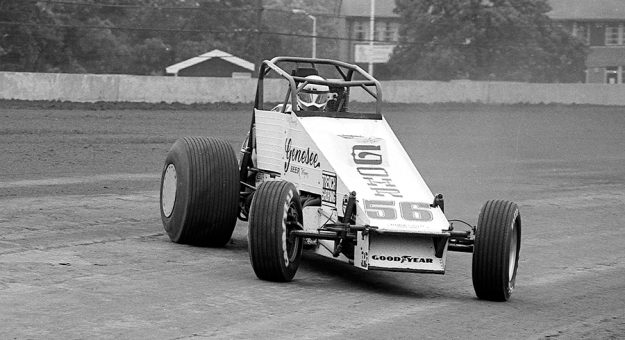The car was extremely versatile. If the wings were removed and it was a sprint car, slap the wings back on and it was a supermodified. A common stomping ground was Madera Speedway, but the team was also willing to wander.
“There were a lot of places we could run it as a super because they didn‘t ban rear-engine cars,” Pankratz said. “We would go to Kalamazoo, Sandusky, Utah, Las Vegas, and we even raced at Star Speedway in New Hampshire against all those giant hitters from Oswego.”
Because of his success during this period, some formed the erroneous assumption that Pankratz was a pavement specialist. In fact, he was still racing regularly at Ascot and after Greg Pieper left the area because of a job change, he began driving for Jim Belifiore.

Belifiore had built an unusual car as well. Pankratz said it may have been the first offset roadster in California. The beat went on, as Pankratz had no problem finding victory lane in this car as well. In 1981, Pankratz won the Super Modified Racing Association title. From 1985 through ‘88, USAC sanctioned supermodified racing. Pankratz proved to be one of the top stars, driving Clyde Prickett‘s car to the series runner-up position in 1985 and ‘86.
Even with all his success, Pankratz knew the racing landscape had changed. Nowhere was this more evident than on the national championship trail. Even so, Pankratz seemed to be in a prime position to make the jump. He excelled on pavement and had already successfully piloted a rear-engine car. Then there was his family history and the fact he was driving a sprint car owned by racing promoter J.C. Agajanian.
Pankratz believed it was time to try to make something happen.
“I was driving J. C. Agajanian‘s car at Ascot and in April of that year I went to his office and asked him if I could drive his Indy car,” Pankratz related. “I really liked Aggie. He was a good guy. He sat down and said, ‘I was afraid you were going to ask me that. I‘ve got a guy named Phil Threshie and he is going to give me an incredible amount of money, doesn‘t want any prize money and if he hurts the car, he will fix it. Can you do that?‘
“End of conversation,” Pankratz continued. “He apologized about it and said, ‘In your dad‘s day or Parnelli‘s day, I would have hired you and given you a retainer for the month because of what you can do on pavement. But as a businessman what should I do?‘ That‘s the end of the story.”
Pankratz did get to run Norm Hall-s flat-bottom Indy car, but in the age of ground effects, the car wasn‘t competitive.
“It was real frustrating,” Pankratz said. “I was raised in a time when motor racing was weird because it was a meritocracy. Guys won races and they got a chance to step up. I mean if you hadn‘t won a feature at some point in your career you couldn‘t get a chance at a champ car.”

Today, Pankratz is philosophical about it all.
“It‘s not fair, and it is fair because that is the way it is. If you want to be a race driver and be a professional driver in the sense of being in IndyCar, you need to get rich first,” Pankratz said. “Not try to get rich driving a race car. Parnelli Jones and Bobby Unser, and people like Johnnie Parsons and Sam Hanks were there on a meritocracy. It was like baseball. They paid their dues, they played in the minor leagues and they did well and went on to the major leagues. Tony Stewart and Jeff Gordon didn‘t buy their way in, so there are a few, but those guys, and people like Kyle Larson are phenome.”
While he may have been forced to recalibrate his ambitions, he still had a powerful desire to race. It is a feeling that has yet to leave him.
He won a sprint car title at Hanford, Calif., in 1985, and from 1987 to 2000, he made 60 USAC Silver Crown series starts. In 1997, the Silver Crown series concluded at The Dirt Track at Las Vegas with Tony Stewart collecting his first series victory and Dave Darland claiming his first USAC title.
It was a bumpy ride for Stewart, who collided with title hopeful Donnie Beechler and Pankratz, who had a chance to win the race.
When interviewed over the PA, Pankratz was diplomatic but agitated. Adding insight about that memorable night, Pankratz said he “saved Tony Stewart‘s life although he doesn‘t know it.”
Pankratz elaborated on the story, “After the race was over Sleepy Tripp came down and had a beer in his hand. He came up to me and said, “What do we need to do here?‘ I wouldn‘t even want to mess with Sleepy, but I told him to let it go. I was most upset for Bill O‘Connor who was one of the owners of the car because it was his chance to win, too.”
The USAC Western States midgets became Pankratz‘s home and between 1986 and 2004, he finished in the top five in the standings 12 times. In 2000, at age 55, he won the series championship.
While Pankratz has coached drivers including Alex Bowman and Kody and Tanner Swanson, he also devoted attention to his daughter Randi‘s racing career.
